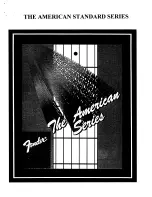
Changing Strings
New strings will breathe new life into
your instrument. There’s no set rule
on how often to change strings, but
while many touring professionals
change them before every performance,
most players don’t change strings
nearly as often as they should. Guild
recommends that the average player
change strings at least once a month.
Don’t wait until your strings break
to change them. Old, worn, oxidized,
pitted and dirty strings will not
hold pitch, and they simply sound
bad. Humidity, oils and acids from
the hands, and other contaminants
interact with the metals in guitar
strings, causing corrosion and
breakdown of the materials.
Remove and replace strings one at
a time instead of all at once. This
prevents sudden and potentially
damaging changes in neck tension.
Each new string should be tuned
up
to correct pitch before the next
one is removed. Always bring a
brand-new string up to pitch slowly,
as rapid stretching can break it.
The gauge and tension of the strings
used on your guitar is critical to its
optimal performance.
Illustration 1
String is passed through hole near top of
string post.
Illustration 3
Prevent string slippage by
running the short end halfway
around the post, then underneath
and back over the main length of the
string before tightening.
Illustration 2
String is then wound halfway
around post.
Orchestra Guitars:
Phosphor Bronze, gauges .012 to .053
Grand Orchestra Guitars:
Phosphor Bronze, gauges .012 to .053
Concert Guitars:
Phosphor Bronze, gauges .012 to .053
Dreadnought Guitars:
Phosphor Bronze, gauges .013 to .056
Jumbo Guitars:
Phosphor Bronze, gauges .013 to .056
Resonator Guitars:
Phosphor Bronze, gauges .013 to .056
12-String Dreadnought and Jumbo Guitars:
Phosphor Bronze 12-String, gauges .010 to .047
Four -String Acoustic Bass Guitars:
Phosphor Bronze, gauges .045 to .100
An inappropriate string can
damage the neck and bridge. Guild
recommends the following strings for
top performance at standard pitch:
Re-Stringing
To string a flat-top, remove the old
strings by unwinding them from the
tuners and pulling out the bridge
pins. To install a new string, drop the
ball end into the hole in the bridge
and re-insert the bridge pin with its
groove positioned over the string. Don’t
hammer the pin into place; a firm push
with the thumb is sufficient. Attach the
other end of the string to the tuning
machine by threading it through
the hole in the tuning machine post,
running it halfway around the post and
then underneath the main length of
the string, and then pulling the string
end back over the main length
(see
illustrations 1, 2 and 3)
.
14
15
Содержание 2014 Acoustic Guitar
Страница 1: ...Acoustic Guitar Owner s Manual ...
Страница 13: ... 2014 GUILD GUITARS 1455 19th St Santa Monica CA 90404 USA ...




















